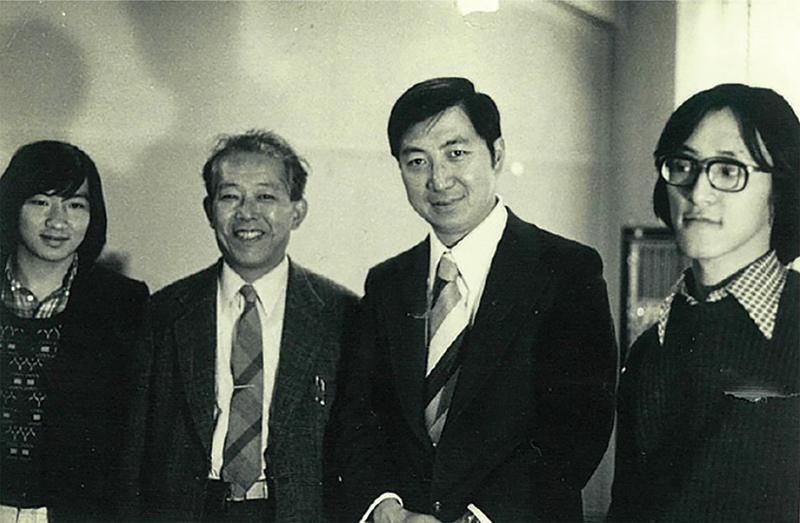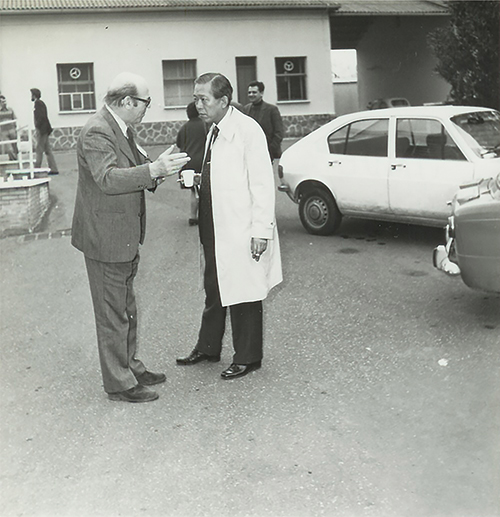Disclaimer: machine translated by DeepL which may contain errors.
Special Article In Memoriam: Masatoshi Koshiba, Special University Professor/Special University Professor Emeritus, The University of Tokyo
Masatoshi Koshiba ( Special University Professor/Special University Professor Emeritus, The University of Tokyo)
D. in 1951 from the Department of Physics, The University of Tokyo, and in 1955 from the University of Rochester, USA (Ph. D.). He became Associate Professor at the Institute for Nuclear Study, The University of Tokyo in 1958, Professor in 1970, and Director of the High Energy Physics Laboratory in 1974 (now the International Center for Particle Physics). After retirement, he became Professor at Tokai University and established the Heisei Foundation for Basic Sciences (where he was appointed Executive Vice President), where he worked to advance basic science and educate young people. In 2002, he was awarded the Nobel Prize in Physics for his work on the detection of cosmic neutrinos.
On the news of the death of Dr. Masatoshi Koshiba
|
The members of the Graduate School of Science are at a loss for words at the news of the sudden passing of Professor Masatoshi Koshiba, Special University Professor/Special University Professor Emeritus at The University of Tokyo. We express our deepest condolences.
 The late Dr. Masatoshi Koshiba
The late Dr. Masatoshi KoshibaAfter graduating from the Faculty of Science of The University of Tokyo, Dr. Koshiba completed his graduate studies in the U.S. and returned to The University of Tokyo, where he served as an Assistant Professor and Professor for many years. In 1987, he was the first in the world to observe neutrinos from a supernova explosion in the Large Magellanic Cloud, for which he received numerous awards, including the Nobel Prize in Physics in 2002. This research also led to Professor Kajita's 2015 Nobel Prize for neutrino oscillation. The entire Science Department is deeply grateful to Dr. Kajita for his great contributions to academia.
After retiring from the University, Dr. Kajita continued to promote the development of basic science, provide research guidance to young people, and educate the public, fostering the development of many researchers. I would like to express my deepest respect for his keen intuition and passion for his research and his sincere personality, and sincerely wish him the best of luck in his final resting place.
In Memoriam: Special University Professor/Special University Professor Emeritus Masatoshi Koshiba
|
Professor Masatoshi Koshiba, Special University Professor/Special University Professor Emeritus of The University of Tokyo, passed away on the evening of November 12, 2020. We would like to express our deepest condolences.
A graduate of the Department of Physics, Dr. Koshiba taught in the Department of Physics from 1963 to 1987, during which time he laid the foundation of neutrino astronomy with the construction of the Kamiokande and neutrino observations from supernova explosions. As an educator, he has trained many outstanding young scientists, and this has led to many achievements that no single researcher alone could have made possible.
When asked what the Nobel Prize in Physics he received in 2002 could do for his research, he proudly replied that it could do nothing. At first glance, this may seem paradoxical, but I believe he was emphasizing the importance of basic research by showing the attitude of the purest physicist who seeks the truth by elucidating the wonders of the natural world.
I remember once visiting his laboratory with a bit of trepidation and nervousness to submit a report on a poorly performed student experiment, but that was the year the Kamiokande was completed. Looking back, it was the year the Kamiokande was completed. I remember how energetic he was then, and I pray for his soulful rest in peace.
Memories of Dr. Koshiba
|
Dr. Masatoshi Koshiba, a giant star of basic science in Japan, passed away on November 12, 2020. He was 94 years old. He was born in Toyohashi City, Aichi Prefecture in 1926, attended Daiichi High School, and graduated from the Department of Physics at the University of Tokyo in 1951, where he became an assistant professor in 1963. I will leave the Kamioka-related matters to Dr. Takaaki Kajita (Special University Professor/Special University Professor Emeritus, The University of Tokyo) and write about the e+e- collision experiment and others.
 Professor Samuel Ting of the Massachusetts Institute of Technology (who won the Nobel Prize in Physics with Professor B. Richter of the SLAC National Accelerator Laboratory for the discovery of J/ψ) was awarded the Nobel Prize in Physics at the University of Tokyo. Physics Prize with Prof. B. Richter of SLAC National Accelerator Laboratory for the discovery of J/ψ) visited the University of Tokyo to give a lecture. The author is on the left.
Professor Samuel Ting of the Massachusetts Institute of Technology (who won the Nobel Prize in Physics with Professor B. Richter of the SLAC National Accelerator Laboratory for the discovery of J/ψ) was awarded the Nobel Prize in Physics at the University of Tokyo. Physics Prize with Prof. B. Richter of SLAC National Accelerator Laboratory for the discovery of J/ψ) visited the University of Tokyo to give a lecture. The author is on the left.In the early 1970s, Dr. Kurokawa recognized the importance of high-energy e+e- collision experiments and started collaborative research with Professor Gersh Budker of Novosibirsk, who was a pioneer in this field, but the project was soon abandoned when Professor Budker collapsed. So, he traveled around Europe and visited the DES in Germany. So, he planned to travel around Europe and participate in the DASP experiment at the e+e- collision storage ring DORIS, which started at the DESY Institute (Deutsches Elektronen-Synchrotron) in Germany. In 1974, soon after the start of this experiment, the J/ψ particle was discovered in the U.S., which set the direction for the current Standard Model of elementary particles. PETRA discovered gluons that mediate strong interactions. In the early 1980s, Europe was planning to build a larger e+e-collider, LEP, at CERN, the Mecca of particle physics, and Dr. Koshiba was the first to get word of this and paved the way for the University of Tokyo to participate. Currently, the International Linear Collider (ILC) is being planned to be constructed in the Kitakami Mountains of Japan as the next e+e-collider after the LEP. The discovery of the Higgs boson at the LHC in 2012 has increased the importance of the ILC, and the construction of the ILC has become an international consensus.
 Dr. Koshiba has a keen eye. With Professor Wolfgang Paul of the Universität Bonn at a meeting at the INFN National Laboratory of Frascati for the launch of the PETRA accelerator in Germany.
Dr. Koshiba has a keen eye. With Professor Wolfgang Paul of the Universität Bonn at a meeting at the INFN National Laboratory of Frascati for the launch of the PETRA accelerator in Germany.Immediately after winning the Nobel Prize in Physics in 2002, he established the Heisei Foundation for Basic Sciences with the prize money and other resources, and has been making great efforts to promote basic sciences by inviting prominent scientists in a wide range of fields as lecturers to hold "science classes for fun," mainly for high school students. He said, "A researcher should always keep a few eggs warm as seeds for future research, and occasionally check to see if they hatch and grow to become big. In the early days of the "Quark Society," an alumni association of the Koshiba Laboratory, he invited as guests everyone from the Director General of the Budget Bureau of the Ministry of Finance, a former schoolmate of his at Daiichi High School, to senior officials of the Communist Party. I met with him for the last time at the November 2019 Quorque meeting. I sincerely pray for the repose of Dr. Koshiba's soul.
Memories of Dr. Masatoshi Koshiba
|
Dr. Masatoshi Koshiba, who invented the Kamiokande experiment and founded neutrino astronomy, passed away on November 12, 2020. As one of the students who participated in the Kamiokande experiment under Dr. Koshiba and learned many things from him, I would like to write about my memories of Dr. Koshiba.
 Dr. Koshiba at the time of construction of Kamiokande (in the water tank of Kamiokande in 1983)
Dr. Koshiba at the time of construction of Kamiokande (in the water tank of Kamiokande in 1983)I heard that it was in the late 1970s that Dr. Koshiba came up with the idea of the Kamiokande for the purpose of searching for proton decay. I became a member of his laboratory as a Master's student in the spring of 1981, just as the 50 cm diameter photomultiplier tubes for the Kamiokande were beginning to be manufactured. This 50 cm diameter photomultiplier tube was the key to the success of Kamiokande. At the time, the IMB, an instrument similar in concept to Kamiokande but about three times the size, was being tested in the United States about a year earlier than Kamiokande. In the end, when the experiment was over, I think it can be said that Kamiokande produced far more results thanks to the 50 cm diameter photomultiplier tube.
Dr. Koshiba always said two things to the graduate students in his laboratory. One was, "We are allowed to conduct experiments with the public's blood money. Therefore, do not waste even a single yen of research funds. When you buy something from a vendor, never buy it at the asking price. He also told me to always keep two or three research eggs in my basket so that I would be able to work as an independent researcher in the future, and to be ready to conduct experiments when the time came. I believe that these teachings have been passed on to many people from Koshiba's laboratory.
Kamiokande was started with the aim of observing proton decay, but when the experiment started, no proton decay was observed. On the other hand, after several months of data showed that the spectrum of electrons emitted from the decay of cosmic-ray muons stopped in water and was clearly visible above about 10 MeV, Dr. Koshiba proposed to modify Kamiokande to observe solar neutrinos, whose spectrum extended to 14 MeV. At the time, Dr. Koshiba said, "We can't just end the experiment with the result that no proton decay signal was observed in the Kamiokande, which we spent so much money to build. Dr. Koshiba was putting into practice exactly what he had said to the students in his laboratory. It was surprising to see such a major change of policy just a few months after the start of the experiment, but the timing of the decision eventually led to the supernova neutrino observation in 1987.
Once the Kamiokande experiment started, Dr. Koshiba made it a daily routine to sit in front of the display every morning and scan the Kamiokande data, and he continued to do so. I think he wanted to be the first to confirm with his own eyes the proton decay or any other interesting event. I feel that his attitude taught me something that we, as researchers, must never forget. We pray that Dr. Masatoshi Koshiba may rest in peace.
Faculty of Science News, January 2021


